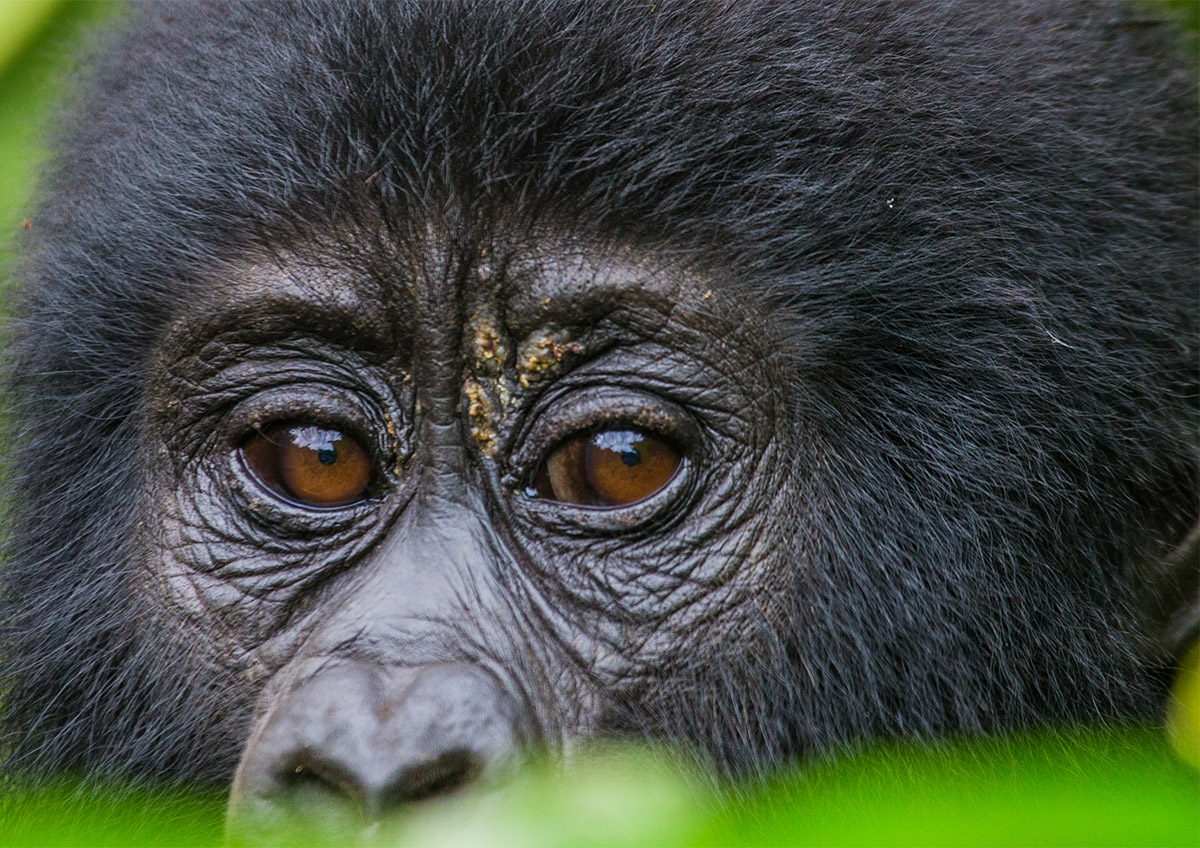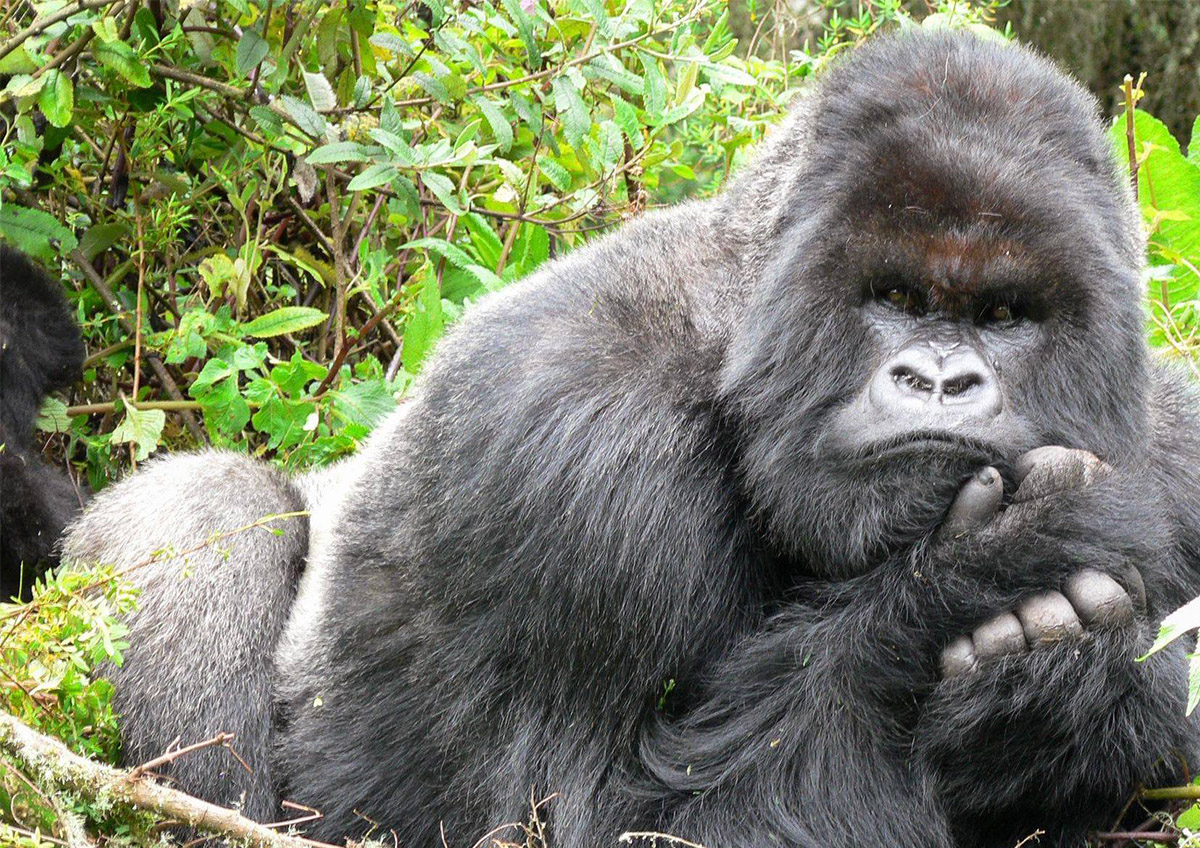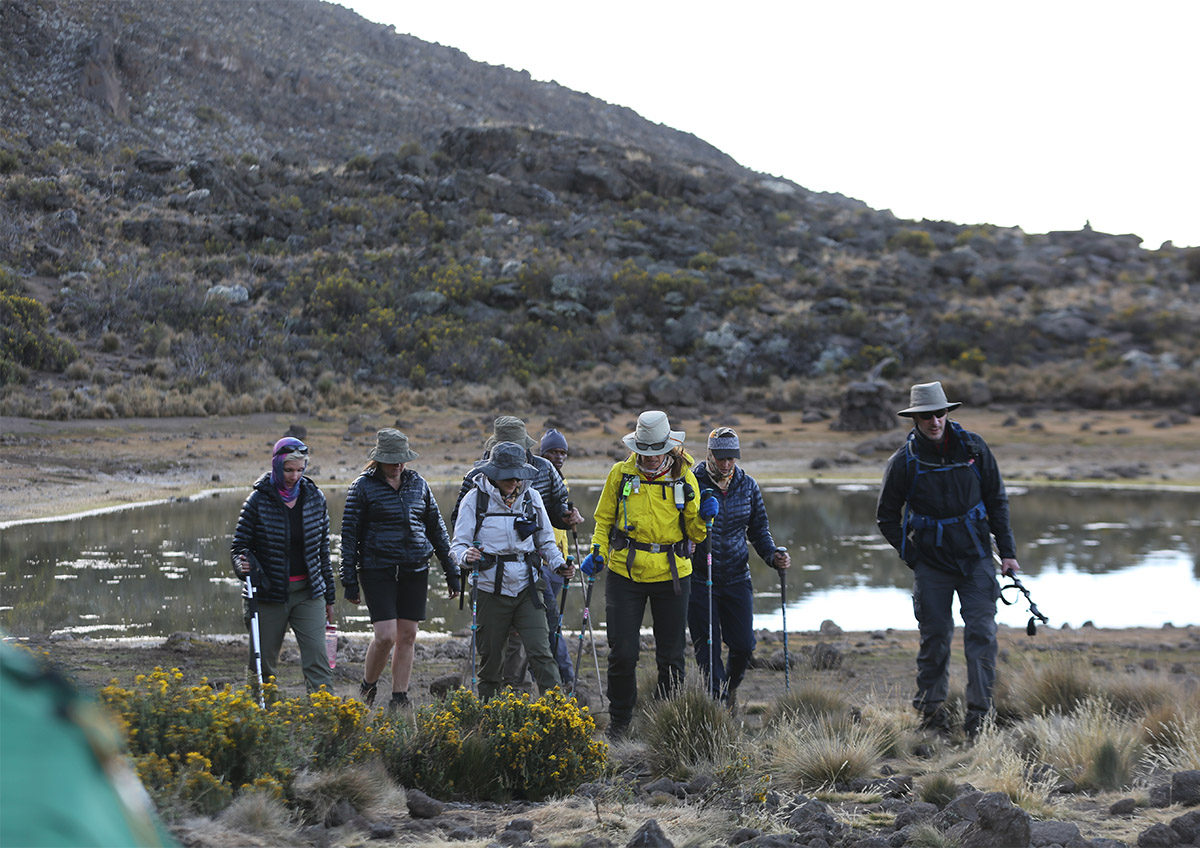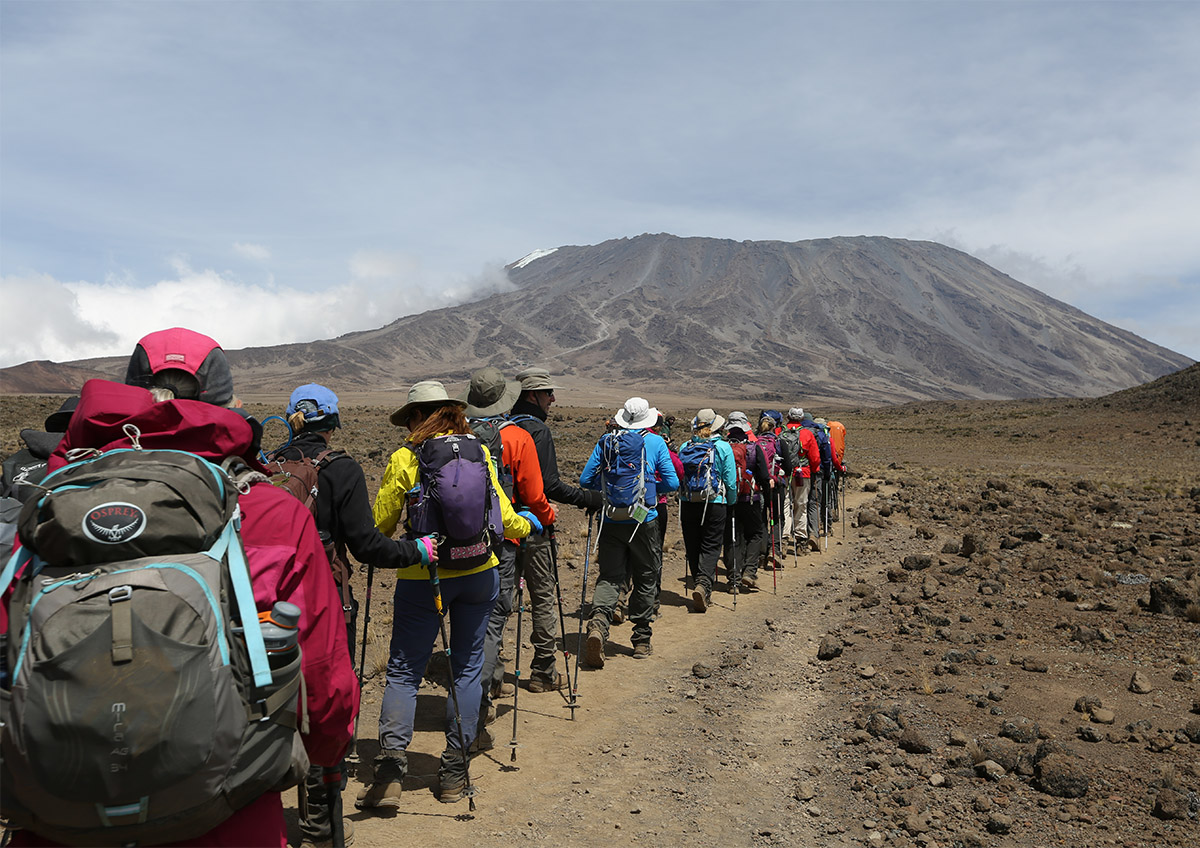Climbing and Trekking Adventure in Africa:
Mountain Climbing and trekking ideas in Africa include the highest and second-highest in Africa, Mt Kilimanjaro in Tanzania and Mount Kenya in Kenya, to Mount Meru and Gorilla trekking in Rwanda and Uganda.
While trekking Kilimanjaro is an all-year-round option, there are, however, a couple of rainy seasons that I don’t recommend. April/May and November-mid-December are best avoided. I think January-Mid March and June – October are the best months as the skies tend to be clear and the mountains quieter. The largest free-standing and highest walkable mountain in the world, Mount Kilimanjaro is a once-in-a-lifetime experience.
The summit is 5,895 meters, (19,340 feet), and while the snow is melting, you can still experience rain or snow on your trek. The night can drop into very cold temperatures and the summit usually ranges between 10C and -20C. This time of year will offer the warmest temperatures and climate.
The Thrilling land of gorillas in Rwanda and Uganda involves a Gorilla trekking in Volcanoes national park Rwanda and Bwindi and Mgahinga in Uganda. A gorilla trek is electrifying. Hiking through lushly sloping hills and spotting a gorilla peeking out from the bush, or happening upon a mother-watching-over-her-babies is a once-in-a-lifetime experience that changes you forever. On an Inquisitive Africa journey, you venture to one of the best places on earth to track gorillas, the exciting Parc National de Volcans (Volcanoes National Park). This 62-square-mile game park is home to the last remaining mountain gorillas as well as the endangered golden monkey, a species of Old-World monkey with a golden-orange patch on his upper flanks and back.
PNV is also one of Rwanda’s conservation epicenters, where visitors see the burial place of legendary scientist Dian Fossey and visit the Dian Fossey Gorilla Fund, which continues her legacy of research and gorilla advocacy. Outside of the park, you experience Rwandan life at its best in its vibrant, bustling local markets.
The country continues to work towards overcoming its turbulent past. Many churches have been converted to places for paying respect to those who died in the 1994 genocide. The extensive, world-renowned Kigali Genocide Memorial has welcomed hundreds of thousands of young people, politicians, and visitors from around the world.
If you’ve dreamed of trekking, climbing, and/or want to experience the amazing Adventure Africa has to offer this is the perfect time to book for your next adventure with us Start by taking a look at what Inquisitive Africa has to offer, including pricing, itineraries, and locations. Ask questions, make plans, and start dreaming about your Adventure trip becoming a reality.
Eccentric Safaris are designed to explore the most amazing destination in Africa
Mount Kilimanjaro (5,895 m – 19,340 ft) is the highest mountain in Africa and the tallest free-standing mountain on the Earth’s land surface, rising some 4,600 meters (15,000 ft). above the surrounding plains and savannas. Kilimanjaro is a triple volcano (it has three peaks) that last erupted more than 100,000 years ago but still exudes volcanic gases.
While climbing it, you will pass from a tropical to an arctic climate in just a few days.
The encircling rain forest ensures the fertility of the lush, lower-lying shamba (country), where the chagga people cultivate their coffee, maize and bananas -Monkeys, birds and Antelopes abound. Elephants and Buffalos range through the forest, and leopards are occasionally seen.
Surprisingly, you may meet herds of eland as high as on the saddle between Kibo and Mawenzi, the two highest summits of Kilimanjaro. Most fit individuals with some mountain walking experience can make it to the top of Africa.
Tracking endangered mountain gorillas through the mysterious intimacy of the rainforest, alive with the calls of 200 species of colorful-birds and chattering of the rare golden monkey, is only one of the truly unique experiences in the area. Situated in the far northwest of Rwanda, Volcanoes National Park protects the steep slopes of this magnificent mountain range, home of the endangered mountain gorilla and a rich mosaic of montane ecosystems, which embrace evergreen and bamboo forest, open grassland, swamp and heath.
Volcanoes National Park is named after the chain of dormant volcanoes making up the Virunga Massif: Karisimbi the highest at 4,507m, Bisoke with its verdant crater lake, Sabinyo, Gahinga and Muhabura.
Within the boundaries of Volcanoes National Park are Buhanga Eco-Park, an ancient forest holding Rwanda’s most intriguing folklore and musanze Caves, formed 62 million years ago after the last estimated volcanic eruption.
Uganda’s gorillas are found in Bwindi National Park and Mgahinga National Park. Bwindi is home to more gorilla families and is generally considered a better area to gorilla track. The number of gorillas in Mgahinga is limited to just one family, and they often cross the border into Rwanda which makes tracking them impossible.
Bwindi has 17 habituated gorilla families across 4 distinct areas, Nkuringo, Buhoma, Ruhija and Rushaga. There are currently a further two families being habituated in Rushaga. The gorillas here live in thick tropical forest and tracking can be challenging as the hillsides can be steep, it can take around 2-8 hours to reach the gorillas.
The parks altitude ranges from 1200-2600 meters and five rivers and a high annual rainfall make it rather humid. The rainforest here is said to be 25,000 years old, and in this time, biodiversity has flourished. Although best known for its mountain gorillas, the National Park is also home to an amazing 120 species of mammal (other primates include chimpanzees and monkeys), 51 species of reptiles and over 200 tree species. In addition, the birdlife is spectacular – 350 species are to be found here, including 23 of the 24 Albertine rift endemic bird species, including the African green broadbill and bar-tailed trogon.
Buhoma Area – Northern Bwindi: There are 4 gorilla families in Buhoma, northern Bwindi, with a maximum of eight visitors allowed to each group per day. The permits are sold in advance, 30% of the permits are sold two years in advance, 50% one year in advance and 20% six months in advance, I therefore encourage you send us your booking as early as possible.
Nkuringo Area – Southern Bwindi: There are 3 gorilla families in Nkuringo, Southern Bwindi, with a maximum of eight visitors allowed per day to each family. The point at which clients begin tracking is right next to the lodges and can pass through interesting local villages and tea plantations on the way into the deeper forest. The ‘Nkuringo’ family is said to be one of the most relaxed and interesting in Bwindi.
3-4 days. Meru is Tanzania‘s second highest mountain and the fifth highest in Africa. Aside from being a rewarding and picturesque trek in its own right, it is also ideal for acclimatizing for your Kilimanjaro trek.
The Serengeti, the largest National Park in Tanzania is one of the most famous National Parks in the world. Its landscape includes large plains, short grass plains, kopjes, and lakes. The name “Serengeti” is derived from the Maasai language, meaning “endless plain”. Every year, more than one million wildebeest travel in long caravans across the plains of the mighty Serengeti, all in search of better feeding grounds, followed by a large variety of other animals. Not far behind follow the hungry lions, cheetahs, and hyena. Other predators such as leopards, serval cats, and jackals watch the wandering game with interest, and elephants, rhinos, and buffalo continue their grazing.
Wildlife Highlights: wildebeest, zebra, lion, leopard, elephant, rhinoceros, buffalo, cheetah, gazelle, giraffe,spotted hyena, jackal, aardwolf, serval, agama lizard, rock hyrax, secretary bird, ostrich, black eagle & most visited park in Tanzania; famous for massive migration of ungulates; more than 500 bird species.
The Masai Mara is one of Africa’s most famous parks. The wildlife viewing is superb throughout the year. The grassy plains and regular rainfall support a huge population of herbivores, in turn attracting many predators. All three big cats are relatively easy to see. The yearly wildebeest migration coming through the park is one of the world’s most amazing wildlife spectacles.
The Great Wildebeest Migration Tracking-Calendar the annual -wildebeest migration of herds in Northern Tanzania and Kenya is one of the world’s most spectacular wildlife events. Often referred to as the ‘Greatest wildlife Show on Earth’, The Great Wildebeest Migration is a movement of approximately 2.5 million wildebeest and zebra throughout the Serengeti and Masai Mara ecosystem. December to March the Wildebeest migration congregates around Ndutu area, in the far south of the Serengeti. April to May, the Wildebeest migration moves north into the plains of the central Serengeti. Between June and July, the Wildebeest migration splits in two; one group goes West into the Western Corridor before crossing the Grumeti River, the other heads directly to the North of the Serengeti. (NB: The annual rut (mating season) takes place between May and July, following the rainy season, when the wildebeest can feed on lush, healthy greens. The best location to spot the migrant animals is in Western Serengeti and Grumeti game reserves). August to October the herd has reformed, and meanders on the Kenya and Tanzania border, along the banks of the mighty Mara River. Returning south from the beginning of November. Unpredictable Nature The path of The Wildebeest migration is dependent on rain. The endless plains of East Africa bear witness to the great annual migration of over a million wildebeest and zebras as they make their way between Kenya and Tanzania in search of fresh grazing pastures. In the latter case, the herds may split and later re-group.
Queen Elizabeth National Park is the oldest & second largest National Park in Uganda, it is located at the base of the massive Rwenzori Mountains, adjacent to lakes Edward & George, covered by Savannah plains that provide an abundance of Game viewing like; Elephants that trumpet when you get too close, lazy Leopards laying in the sun, abundant Gazelle and buck, Lions, Buffaloes, Hippos and others.
One of nature’s true wonders and a photographer’s paradise! The crater, a UNESCO world heritage site, is the largest unbroken volcanic caldera on the globe. It is 610m deep and the flat crater floor covers 265 square kilometers. The steep sides of the crater mean that it has become a natural enclosure for a very wide variety of wildlife including elephants, black rhinoceros, hippopotamus, buffalo, cheetahs, lion, leopard, spotted hyena, serval cats, jackals, bushbucks, elands, waterbucks, wildebeest, mountain reedbuck, Many antelopes and large variety of Birds such as ostrich, kori bustard, papilio sjoestedti. The crater is a sight that you will always remember. However the Ngorongoro conservation Area offers more than just the crater. Many archeological and paleontological sites: Olduvai Gorge, Laetoli, The crater highland is a beautiful and unique landscape with alkaline soda lakes, a series of peaks and volcanoes, dense rainforest, and remote Maasai villages.
Ruaha is a remote stronghold of spectacular wilderness, undisturbed wildlife, and breathtaking scenery. With vast concentrations of elephants, buffaloes, zebras, lions and leopards, and over 400 bird species, Ruaha’s limitless wilderness is a naturalist’s paradise.
Wildlife Highlights: elephant, hornbill, kingfisher, Sunbird, white stork, African wild dog, sable antelope, greater kudu, crested barbet, yellow-collared lovebird & more than 400 bird species, high diversity of antelopes
The Selous Game Reserve, another UNESCO world heritage site is the largest protected area on our planet, covering an area of around 50,000 sq. km. Its size is stunningly bigger than Switzerland or Denmark, uninhabited and little touched by human interference. Visitors can find themselves in a pristine wilderness, far away from the trodden tourist routes.
The Selous, whose aorta is the mighty Rufiji River has a spectacular wildlife with some mammal populations (buffaloes, elephants, hippos, wild dogs and crocodiles) being the largest in Africa. Nowhere else can one do boat and walking safaris through more spectacular wildlife concentrations. There are around 440 species of birds in the Selous, making it a prime spot for bird watchers. The landscapes vary from open grassland to acacia and miombo woodlands, and to riverine forests.
Tarangire includes two large plains and a seasonal swamp in the South. The park is filled with baobab and acacia trees. During the dry season herds of thirsty animals such as zebras, elephants, giraffes and waterbucks wander hundreds of perched miles to the Tarangire River, knowing that there can be water found – always. Also the park’s birdlife is varied and plentiful.
Wildlife Highlights: oryx, gerenuk, elephant, baobab, lesser kudu, African wild dog, lion, kori bustard, ground hornbill, ostrich, yellow-collared lovebird, Rufous-tailed Weaver, ashy starling, dwarf mongoose, red-and-yellow barbet & 550 bird varieties; largest concentration of wildlife behind Serengeti
Crowned by Mount Kilimanjaro, Africa’s highest peak, the Amboseli National Parks is one of Kenya’s most popular parks. The name “Amboseli” comes from a Maasai word meaning “salty dust”, and it is one of the best places in Africa to view large herds of elephants up close. Nature lovers can explore five different habitats here ranging from the dried-up bed of Lake Amboseli, wetlands with Sulphur springs, the savannah and woodlands. They can also visit the local Maasai community who live around the park and experience their authentic culture.
Lake Manyara is famous for its birdlife – almost 400 different species of birds can be found in and around the impressive ground water forests which are also home to tree climbing lions, elephant populations and diademed monkeys. There is a large variety of tree species within the park.
Wildlife Highlights: elephant, Cape buffalo, lion, hippopotamus, impala, giraffe, zebra, wildebeest, bushbuck, leopard, baboon, lesser, flamingo, greater flamingo, white pelican, yellow-billed stork, white-breasted cormorant, palm-nut vulture, Ayres Hawk-eagle, Nile monitor, cobra & greatest biomass density in the world; tree-climbing lions.
Scenic Lake Nakuru is Kenya’s most popular national park. The park’s main feature is a large, shallow lake supporting great birdlife, including big flocks of pelicans and variable flocks of flamingos. The lake was once famous for its flamingos, however, since 2012, conditions have become unfavorable for these birds and most have moved to other Rift Valley lakes.
Lake Nakuru offers easy wildlife viewing of most big safari animals with the exception of elephants. Black and white rhino were reintroduced in the 1990s and have bred to healthy populations. White rhinoceros are usually easy to see on the lakeshore. Rothschild giraffe, buffalo and hippo are numerous as well. Lucky visitors might see lions, which occasionally climb trees. Leopard are present, but not often encountered.
When you start planning your visit to Africa, you may find it challenging to book local flights for your travel from one place/point to another within Africa. Please feel free to tell us and we would be happy to help you arrange flights. Just ask for an air quote when making your booking.



